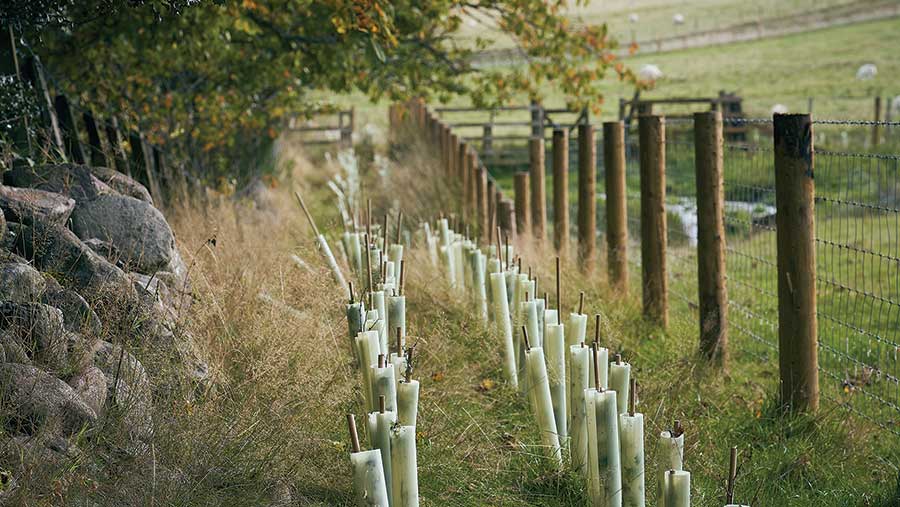Advertiser content
How to ‘green up’ your boundaries with hedgerows
 Photo credit - Matthew J Thomas/iStock
Photo credit - Matthew J Thomas/iStock With the government push for net zero by 2050, it is becoming key for farmers to become both even greener and even more productive. Hedgerows are a great way to accomplish this.
Traditionally, hedgerows were used for both livestock and crop management. Today, they can provide multiple benefits.
Farmers can use hedgerows to create a physical boundary on land, provide shelter for wildlife and natural pollinators, promote soil health and prevent soil erosion. They can also produce food and other products.
The benefits of hedgerows
Hedgerows can be more than just a pretty addition to your farm. These plant barriers can provide numerous benefits to your land and the environment. Here are just a few reasons why you should consider planting hedges:
- Habitat for wildlife: Hedgerows offer habitat for birds, small mammals, and insects. These habitats can increase biodiversity on your farm, improving ecosystem health
- Soil protection: Hedges help prevent soil erosion and keep soil healthy. The roots of the hedges bind the soil together, protecting it from wind and water erosion
- Wind protection: Hedgerows can act as windbreaks, providing shelter for crops and livestock. This protection can help increase crop yields and decrease stress on your animals
- Pest management: Hedges can provide habitat for natural predators of pests, helping control insect populations and reducing the need for pesticides
- Carbon sequestration: Hedges store carbon in their biomass and can help offset greenhouse gas emissions. There may, in the near future, be an opportunity to also sell carbon via the Hedgerow Carbon Code
- Aesthetic value: Let’s not forget the aesthetic benefits of hedgerows. These plant barriers can provide a beautiful and natural addition to your farm landscape.
Overall, hedgerows are a beneficial addition to any farm. With so many advantages, it’s hard to find a reason not to plant them.
Planting and maintaining hedgerows
Once you’ve decided to plant hedgerows on your farm, the next step is to figure out the logistics of planting and maintaining them. Here are some tips to keep in mind:
- Choose the right partner: Hedges require regular maintenance to keep them healthy and looking neat. Tilhill is the leading provider of nature-based solutions in the UK. Our professional managers can maximise the grant funding available and ensure thriving and healthy hedgerows emerge with expert management
- Timing is important: Hedges can be planted in both spring and autumn, but autumn planting is usually preferred because it allows the roots to establish before the plant begins to grow in the spring. Planting in early autumn, when the soil is still warm, is recommended
- Prepare the soil: Make sure to prepare the soil by removing any weeds or grasses in the planting area. Digging a narrow trench will make it easier to plant and ensure the roots are well covered
- Choose the right plants: Choosing the right species of plant for your hedgerow will depend on the specific climate, soil conditions, and the reason for planting the hedge. You can choose between deciduous or evergreen plants, shrubs, or trees. Native plants are also recommended, as they are best adapted to local conditions and attract beneficial insects.
There are attractive grants to support hedging, but planting hedgerows on your farm can be a long-term investment in your agricultural landscape and biodiversity.
By choosing the right plants, preparing the soil correctly, and maintaining them well, your hedgerows will provide valuable habitats and benefits to your farm for years to come.
Working together, our goal is the same as yours: to secure a sustainable future for your farm business.
Types of hedges to consider
When it comes to planting hedgerows, there are many different types of hedges to choose from. Some popular options include:
- Hawthorn: Hawthorn hedges are native to the UK and have sharp thorns, making them an excellent deterrent for livestock. They also produce berries that are a valuable food source for birds and small mammals
- Beech: Beech hedges are deciduous and can grow up to 4m tall. They are often used for formal hedgerows as they keep their leaves during the winter months. Beech hedges are great for attracting wildlife and provide excellent shelter for birds
- Blackthorn: Blackthorn hedges are native to Europe and are often used to create a dense barrier. They have white flowers in the spring and black fruits in the autumn, which are a great food source for birds
- Hazel: Hazel hedges are deciduous and grow up to 5m tall. They are often used to create a windbreak and provide excellent cover for wildlife. Hazel nuts are also a valuable food source for small mammals and birds
- Privet: Privet hedges are evergreen and are often used for formal hedgerows. They are fast-growing and can be easily trimmed to create a neat and tidy hedge.
When choosing which type of hedge to plant, consider your farm’s needs and the local environment.
Native hedges are always a good option as they provide important habitats for local wildlife.
Maintenance is also important with hedgerows, to keep them healthy so they continue to provide the many benefits they offer, and Tilhill’s expert managers can help you every step of the way.
For more information on how to get hedgerows working on your farm please email Simon Marrington on simon.marrington@tilhill.com or call 07825 193278.
Visit tilhill.com for more information on how trees can help you and your farm business.
Provided by
Tilhill Forestry offers farmers a professional one-stop service for selling woodland generated carbon units, woodland creation, management, and timber harvesting. We help farmers get even better value from otherwise less productive land.
